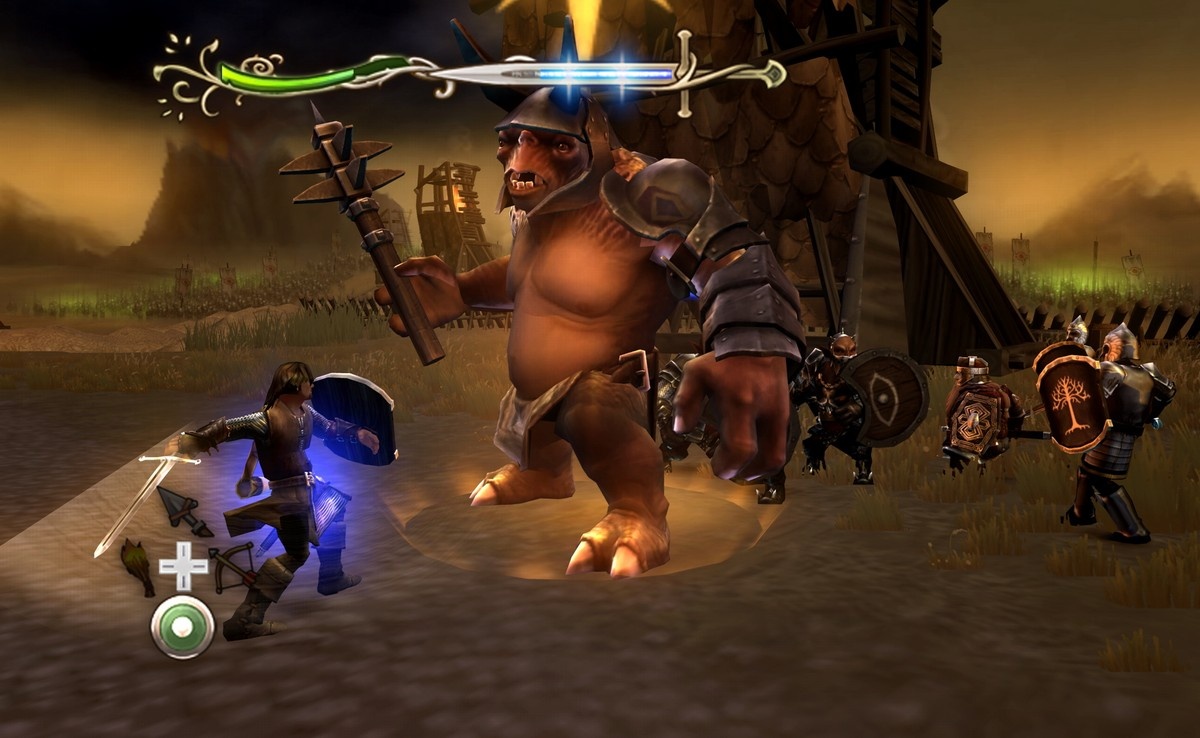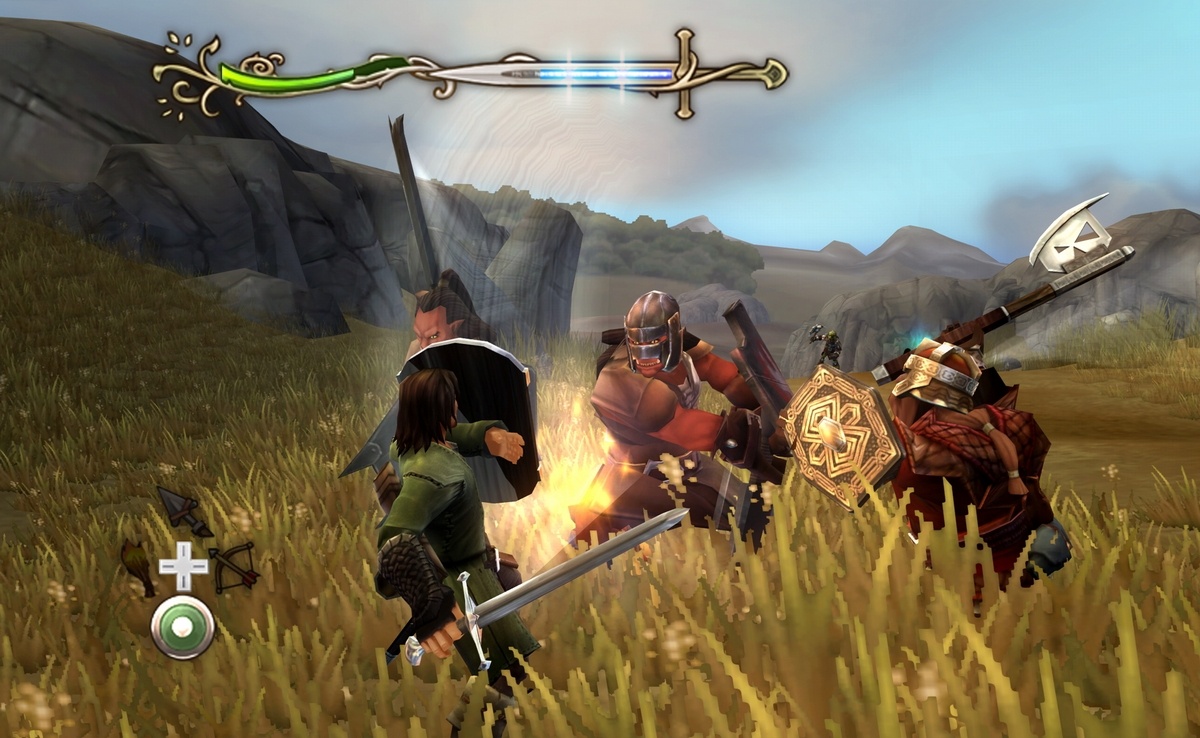Recapturing the sense of heroic adventure that made the Lord of the Rings films such a huge success is no easy task. But in Aragorn's Quest, Headstrong Games has managed to do just that, crafting a game that feels like a reverent tribute to the source material while managing to be enjoyable on its own. Though its motion-control combat leaves something to be desired, Aragorn's Quest is an epic journey that does a fine job of putting you in the boots of the scruffy ranger who would be king.
Aragorn's Quest opens as the king of Gondor and his faithful companions stand at the Black Gate of Mordor and are about to fight a desperate battle against the vast host of Sauron. After a brief bit of swordplay, things take a shocking turn that's completely out of keeping with both Tolkien's books and Jackson's films; it seems for a moment that this game is going to play fast and loose with the mythology of Middle-earth. But then the truth is revealed: This isn't actually the battle at the Black Gate we're seeing but a reenactment by some imaginative hobbit children in the Shire, some years after the War of the Ring has come to a close. These are none other than the children of Sam Gamgee, and as the Shire prepares for a grand party in honor of a visit from the king and queen, Sam tells his children the tale of Aragorn's adventures, from his first meeting with the hobbits in the rainy village of Bree to that final clash at the gates of Mordor. Aided by a fine voice performance by Sean Astin, reprising his role of Sam from the films, this charming storytelling device makes Aragorn's Quest feel like a minor follow-up to the events of the epic trilogy.
As Sam recounts Aragorn's journeys with the hobbits and beyond, you take control of the titular hero in eight vast levels that do a surprisingly good job of evoking the atmosphere of those locations from the films. These areas include the lush, autumnal Rivendell and its surroundings; the wide-open plains of Rohan; and the grim fortress of Helm's Deep. As you progress through each location, you're presented with various quests--both mandatory and optional--and you must fend off attacks from orcs, trolls, wargs or other evil creatures. The combat in Aragorn's Quest is a motion-controlled affair; waving the Wii Remote in various directions will result in Aragorn swinging his sword horizontally or vertically or thrusting with it. It's a bit imprecise--you might make a thrusting motion with the remote only to see Aragorn swing his sword from left to right, for instance. But it rarely matters because the combat is also very easy.
Onscreen prompts encourage you to use specific attacks at certain times to stun enemies, and in those particular moments, it can be frustrating to have your movement misread and have Aragorn perform the wrong action, but you're almost certain to make short work of your enemies regardless. As you advance through the story, you also frequently acquire tokens that make you and your computer-controlled companions more powerful, as well as new abilities that can embolden your comrades and strike fear into your opponents. All of this creates a rewarding sense of growth but also makes the already-easy combat even easier. This lack of challenge certainly makes the game more accessible to younger players, but it also means that those looking for some intense swordplay will be disappointed. Still, there is a certain satisfaction in swinging the remote and seeing Aragorn cut down three orcs in one fell swoop or in mounting a horse and effortlessly charging through a row of imposing uruk-hai. With the constant unlocking of new abilities and equipment, as well as the need to periodically switch to a bow and take out enemies from a distance, there's a fair amount of variety to the combat, even if there isn't much challenge.

But the greatest strength of Aragorn's Quest comes not from its diverting but unspectacular combat, but the way it so accurately captures the atmosphere of the locations in the films and the resulting pleasure that comes from adventuring in these memorable Middle-earth locales. If you stick to the main quests, you can rush through each area rather quickly, but there's plenty of incentive to take your time doing the numerous side quests and exploring the nooks and crannies of these realms. That incentive comes in the form of collectible lore items that flesh out the characters and history a bit, money to buy artifacts that bestow various bonuses, and the like. For fans of the films, the chance to wander through faithfully re-created versions of places like the Mines of Moria and the Pelennor Fields is its own reward. And while Aragorn's Quest is a family-oriented game, that doesn't mean that it entirely eliminates the sense of dread and fear that gave the darker moments of the films their power. The shrieks of the Nazgul are still bone chilling, and the battle at Helm's Deep feels like a hopeless stand against impossible odds.
Periodic interludes take you back to the idyllic Shire, where you play as Sam's young son, Frodo Gamgee through a series of tutorial sequences, and these, along with Sean Astin's warm narration, help keep the overall tone of the game light even when you're traveling through darkness. Should any younger players feel daunted by the prospect of taking on the servants of Mordor alone, a second player can join in at any time as Gandalf. Gandalf is a powerful support character who can hurl devastating fireballs and heal Aragorn, making this a very good way for parents or older siblings to offer a helping hand on Aragorn's journey.
The environments impress with their variety, attention to detail, and the way they so faithfully reflect the visual style of the films. The Shire's vibrant green fields, little gardens, and blue rivers make it a joy to frolic in, while the massive scale of the Dwarven city of Dwarrowdelf inspires awe. Other aspects of the visuals are a bit less impressive, though. The enemies you battle are often vast in number but lacking in detail, and figures are sometimes seen passing right through each other or standing in midair.

The game's score makes use of occasional snippets of music from the movies, but it's mostly original music that's in the spirit of the compositions from the films and swells up dramatically whenever enemies approach. (This is sometimes your only way of knowing that orcs are approaching you from behind.) While Sean Astin's voice is a constant presence and John Rhys-Davies supplies a few new lines of gruff banter as Gimli, for the most part, the dialogue is lifted straight from the films. And this works fine, at least until the game's final scene, which uses existing dialogue to recycle one of the emotional high points of the films in a way that feels clumsy and hollow here.
Aragorn's Quest is a game that's clearly designed to give families and younger players a chance to share a Lord of the Rings experience, but it would be a mistake for anyone to write this game off as something that can only be enjoyed by kids. On the contrary, this is a good adventure for would-be Aragorns of any age. It does a particularly fine job of evoking the memorable locations of Middle-earth, so those with a deep appreciation for Tolkien's books or Jackson's films may have an easier time overlooking the game's faults. But even those adventurers who go in with no knowledge of the War of the Ring will enjoy taking up the mantle of Aragorn and hearing his tale told by a simple hobbit.